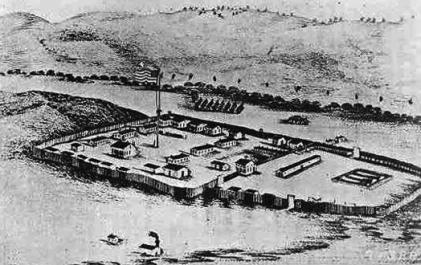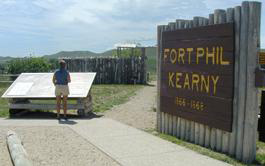- Home
- Encyclopedia
- Fort Phil Kearny
Fort Phil Kearny
The largest of the three forts built along the Bozeman Trail leading to the gold fields in Montana, Fort Phil Kearny was established by the U.S. Army on July 15, 1866 near present-day Story, Wyo. Along with Fort Reno northeast of present Kaycee, Wyo. and Fort C.F. Smith near Hardin, Mont., Fort Phil Kearny’s original purpose was to protect freighters, gold prospectors and other travelers along the “bloody Bozeman” from attack by Plains Indians wary of further encroachment by pioneers and the military.

Additionally, the fort, named for a Union general and under the command of Col. Henry B. Carrington, was intended to prevent inter-tribal warfare in the region and keep the Indians away from the Union Pacific Railroad under construction hundreds of miles to the south.
An 8‑foot‑tall wooden stockade fortified Fort Phil Kearny’s 17 acres. Two major battles, the Fetterman Fight and the Wagon Box Fight, occurred near the fort along with numerous smaller skirmishes. The Fetterman Fight in December 1866 resulted when Capt. William Fetterman allowed himself and his troops to be lured over a hill north of the fort and out of sight of it. He and all 80 men in his command were killed by Cheyenne, Arapaho and Oglala Sioux warriors.
The Wagon Box Fight, in August 1867 a few miles west of Fort Phil Kearny, developed when 32 woodcutters and guards were attacked by the forces of Oglala Chief Red Cloud. The men defended themselves with new breech-loading rifles, firing from a corral of wagon boxes and staving off the Indians until help arrived from the fort.
 After the U.S. government proposed and the tribes signed the Fort Laramie Treaty of 1868, the forts along the Bozeman Trail were abandoned. Shortly after the troops left Fort Phil Kearny in the summer of 1868, it was burned down, probably by Cheyenne forces.
After the U.S. government proposed and the tribes signed the Fort Laramie Treaty of 1868, the forts along the Bozeman Trail were abandoned. Shortly after the troops left Fort Phil Kearny in the summer of 1868, it was burned down, probably by Cheyenne forces.
Fort Phil Kearny was named to the National Register of Historic Places in 1962. Now, trails lead visitors to the sites of the conflicts, and interpretive signs explain the events from the perspectives of both the military and Indian groups.
Resources
- Brown, Dee. The Fetterman Massacre (formerly Fort Phil Kearny, an American
Saga). Lincoln: University of Nebraska Press, 1984. - Fort Phil Kearny State Historic Site. Accessed 10/27/11 at http://philkearny.vcn.com/.
- National Register of Historic Places. “Fort Phil Kearny (and Associated Sites) National Historic Landmark, accessed 10/27/11 at http://wyoshpo.state.wy.us/NationalRegister/Site.aspx?ID=201.
Illustrations
- The 1867 image of Fort Phil Kearny is from Wyoming Tales and Trails. Used with thanks.
- The contemporary photo is from the Fort Phil Kearny State Historic Site website, used with permission and thanks.
